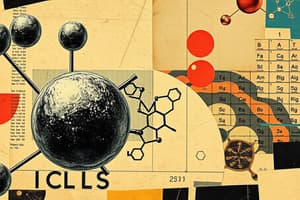Podcast
Questions and Answers
Which subatomic particle determines the element's chemical properties and identity?
Which subatomic particle determines the element's chemical properties and identity?
- Neutrons
- Protons (correct)
- Positrons
- Electrons
What are the three main parts of an atom?
What are the three main parts of an atom?
- Neutrons, positrons, electrons
- Protons, electrons, neutrons (correct)
- Protons, photons, neutrons
- Electrons, muons, positrons
In an atom, where are protons and neutrons located?
In an atom, where are protons and neutrons located?
- Within the electron clouds
- In the electron orbitals
- In electron shells
- Around the nucleus (correct)
What type of bond is formed when atoms share electrons?
What type of bond is formed when atoms share electrons?
How many protons do carbon atoms have?
How many protons do carbon atoms have?
Which part of an atom orbits around the nucleus in electron orbitals?
Which part of an atom orbits around the nucleus in electron orbitals?
What is the role of protons and neutrons in an atom?
What is the role of protons and neutrons in an atom?
Which subatomic particle interacts very weakly with matter?
Which subatomic particle interacts very weakly with matter?
How do electrons contribute to chemical reactions?
How do electrons contribute to chemical reactions?
What determines an element's stability and nuclear reactions?
What determines an element's stability and nuclear reactions?
Which part of an atom contains protons and neutrons?
Which part of an atom contains protons and neutrons?
Where do electrons reside based on their orbital energies?
Where do electrons reside based on their orbital energies?
Flashcards are hidden until you start studying
Study Notes
Atomic Structure: Understanding Atoms, Molecules, Nuclei, Electrons, and Subatomic Particles
In the realm of chemistry, understanding atomic structure is crucial for comprehending the behavior of matter at its core. The atomic structure refers to the organization of protons, neutrons, and electrons within an atom, along with the interactions among these subatomic particles. This knowledge provides insight into various aspects of nature, from chemical reactions to quantum mechanics. Let's delve deeper into the topics of atoms, molecules, subatomic particles, nuclei, and electrons.
Atoms
An atom is the basic building block of matter. It consists of three main parts: protons, neutrons, and electrons. Protons and neutrons are located in the nucleus at the center of the atom, while electrons orbit around the nucleus in shells known as electron orbitals. The number of protons determines the element's chemical properties and identity. For example, hydrogen atoms have one proton, while carbon atoms have six protons.
Molecules
A molecule is a group of two or more atoms bonded together by shared electrons. When atoms share electrons, they form covalent bonds, which create a stable electronic configuration for each atom involved in the bond. Water (H2O), for instance, consists of two hydrogen atoms and one oxygen atom sharing electrons to form a water molecule.
Subatomic Particles
Subatomic particles are smaller than atoms and include protons, neutrons, electrons, and other unstable particles like neutrinos and quarks. Protons and neutrons, collectively known as nucleons, make up the atomic nucleus. Electrons are located outside the nucleus in electron orbitals. Neutrinos have no electric charge and interact very weakly with matter, while quarks combine to form protons and neutrons.
Nucleus
The nucleus is the dense central part of an atom that contains protons and neutrons. The number of protons determines the element's chemical properties and identity, while the number of neutrons affects the atom's stability and nuclear reactions. In most elements, the number of neutrons is close to or equal to the number of protons, which makes the nucleus stable. However, some elements can have unbalanced numbers of protons and neutrons, leading to instability and radioactive decay.
Electrons
Electrons are subatomic particles that occupy electron orbitals around the nucleus of an atom. They contribute to chemical reactions by participating in covalent bonding and forming ions (positive or negative) when they gain or lose electrons. Each element has a specific number of energy levels called electron shells or principal quantum numbers, where electrons can reside based on their orbital energies.
In summary, understanding atomic structure involves studying various aspects such as atomic composition, interatomic forces, and quantum mechanical principles governing the arrangement of subatomic particles. This knowledge paves the way for advancements in diverse fields ranging from materials science to biochemistry and astrophysics.
Studying That Suits You
Use AI to generate personalized quizzes and flashcards to suit your learning preferences.




